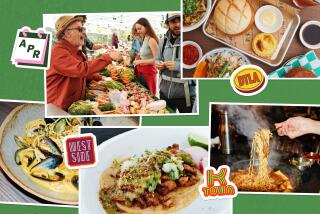What’s up with the cookbook industry these days
Back around 2010, a dark mood began to press down on the hardback cookbook industry, something that Ten Speed’s vice president and imprint publisher, Lorena Jones, called “a prevailing sense of doom.” The first-generation iPad had just hit the stores, igniting an industrywide belief that tablets and increasingly sophisticated mobile phones were going to make hardcover books extinct. As panic set in, publishers scrambled to take their paper-and-ink products digital, offering up apps and enhanced e-books awash in food photos and user friendly how-to videos.
“An exact quote was, ‘Nobody is going to be using cookbooks anymore,’” said Rux Martin, editorial director of Rux Martin Books at Houghton Mifflin Harcourt. “To which I said, ‘Really?’ No one I knew who is serious about food was going to use e-readers. I live in Vermont, so I’m sure people dismissed me as one of those dinosaurs. Which I am. But guess who was right?”
Statistics bear this out. This year, one of Martin’s most popular acquisitions, Michael Solomonov’s “Zahav” cookbook, which retails at $35, sold more than 60,000 copies. Ten Speed will have published at least 30 books in the food and spirits category by the end of 2016; Phaidon will have released 20 titles. Culinary dynamo Ina Garten’s latest “Cooking for Jeffrey: A Barefoot Contessa Cookbook” is currently holding the No. 8 spot in all categories on Amazon.
While the flattening of e-books sales has inspired a lot of head-scratching analysis, when it comes to cookbooks, experts like Mark Rotella, a senior editor at Publisher’s Weekly, say the physical cookbook seems to be flourishing.
“It’s at least just as healthy, if not more of a market,” said Rotella by phone from Manhattan. He did a quick eyeball estimation of his office. “My shelves are full,” said Rotella, who has long covered the cookbook industry and compares the public’s affection for physical over digital cookbooks to the children’s book market, which actually gained ground in 2015. “There’s just something about an illustrated book.”
But why were predictions so off the mark? One reason the digital solution didn’t fly was that so many new types of dedicated e-readers and smartphones rolled out that no one could crack the code of how to offer a consistent quality reader experience. Then there was the simple fact that splashing hot olive oil on a $300-plus gadget is appetite-spoiling. But from Jones’ perspective, the biggest misstep was not understanding that after a few years of being carpet-bombed by feature-rich apps, blogs, websites and recipe databases, cookbook fans would get user fatigue.
“That great blossoming of so much content was wonderful — until it was totally oppressive and overwhelming and hard to get through. There was no filter; you became the filter,” said Jones, who characterized the act of cozying up to a hardback collection of recipes as a sort of retreat from the world of digital noise of voice prompts, bleeping timers and helpful glossaries into a quiet room of focused satisfaction. “It led to an incredible craving for something that was mind-calming, not illuminated. The consumer response was, ‘Wow, I want a physical format to hold in my hand; I want to get off of my screen and silence all the disruptions.’”
Another thing that made recipe-seekers shy from apps, recipe databases and food blogs in favor of their favorite dog-eared print cookbooks, the ones with sauce-stained pages and notes scribbled in the margins? Emilia Terragni, publisher of Phaidon Books, says it has to do with the system of standards that’s in place at every publishing house. To post an entry on a recipe aggregator, all that’s required is a list of ingredients, a bit of how-to explanation and the ability to press “send.” A pricey cookbook goes through a laborious process in which recipes are written, copy edited, tested, retested and fact-checked.
“The most important thing [with a cookbook] is the quality of the recipes, that they work well, that they’re well-explained, that you can follow them easily,” said Terragni, adding that diving into a meticulously organized, thoughtfully written print cookbook can set a reader sailing on a tantalizing food adventure in a way that just doesn’t happen online. “The way in which books are put together, the selection of the recipes, the photographs, the idea of going back and forth when you turn the page. It’s an experience that I think the digital format hasn’t managed to reach in the same way.”
These days, it’s still de rigueur for publishing houses to offer an e-version of every physical cookbook they release, even if the e-versions account for a small fraction of sales. (“About 5%,” estimates Martin.) But ask Ten Speed’s Lorena Jones how her industry’s voyage into the digital sea affected the production values of the modern cookbook and she’ll tick off a long list — for example, the books that go crazy with their photography budget and page count.
“If we’re going to charge $35 or $40 for a cookbook, we feel like we have to put so much more material into it for that perceived value to be there,” said Jones about cookbooks that clock in at 350 pages with 150 to 200 photographs.
Then there’s the reaction to the coldness of digital, something that explains the trend of the past two years of jacketless cookbooks, deglossed paper and texturized surfaces — cookbooks that are fun to hold.
“By the winter of 2014, e-books had completely plateaued and we realized that we had to make books deliver that tactile experience,” says Jones. “And it was at that moment that we all looked around and recognized, ‘Wow, we held our ground.’”
More to Read
Eat your way across L.A.
Get our weekly Tasting Notes newsletter for reviews, news and more.
You may occasionally receive promotional content from the Los Angeles Times.






